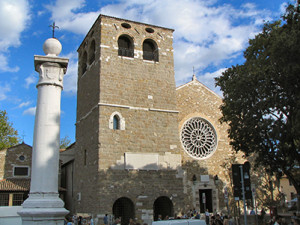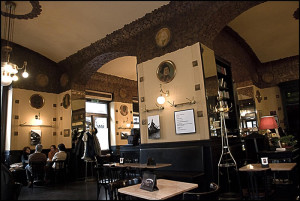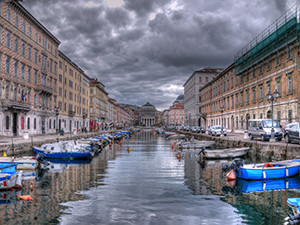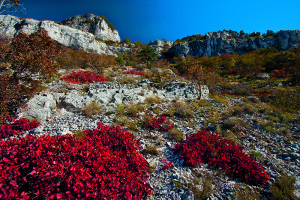 The Trieste Karst (“Carso Triestino” or Kras in Slovene) is a rocky limestone plateau that extends above the city of Trieste, between the sea and the mountains. Some of its towns and villages are predominantly Slovene speaking.
Geologically, the area is characterized by very soluble minerals: limestone, dolomites and evaporitic rocks (deposited by evaporation of ancient oceans). Since these rocks are relatively easily soluble in water,
The Trieste Karst (“Carso Triestino” or Kras in Slovene) is a rocky limestone plateau that extends above the city of Trieste, between the sea and the mountains. Some of its towns and villages are predominantly Slovene speaking.
Geologically, the area is characterized by very soluble minerals: limestone, dolomites and evaporitic rocks (deposited by evaporation of ancient oceans). Since these rocks are relatively easily soluble in water, they are easily shaped by the rain, which makes characteristic grooves, sometimes very deep.
Interesting surface features are the “doline”: funnel-shaped depressions from 1 to 30 meters deep and up to hundreds of meters wide.
The Karst is generally without rivers or streams on the surface; water flows underground, occasionally resurfacing after a long underground course. An example is the River Timavo, which goes underground near Škocjan in Slovenia, only to resurface after 40 km near Monfalcone. The area is also riddled with caves: the most important are the Grotta Azzurra and Grotta Gigante.
they are easily shaped by the rain, which makes characteristic grooves, sometimes very deep.
Interesting surface features are the “doline”: funnel-shaped depressions from 1 to 30 meters deep and up to hundreds of meters wide.
The Karst is generally without rivers or streams on the surface; water flows underground, occasionally resurfacing after a long underground course. An example is the River Timavo, which goes underground near Škocjan in Slovenia, only to resurface after 40 km near Monfalcone. The area is also riddled with caves: the most important are the Grotta Azzurra and Grotta Gigante.
Trieste
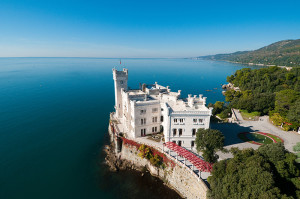 Trieste, the most multicultural city of the region, is sometimes called the "little Vienna by the sea" because of its close historical ties with Austria (of which it was the second most important city, thanks to its port, up to the First World War). In the centre one can find sailing boats alongside antique shops, fashion shops, important churches and many monuments.
From the quayside, in the distance on can make out the white outline of Miramare, the romantic castle of Maximillian and Carlotta of Habsburg, which along with the Castle of San Giusto, near the Cathedral on the hill of the same name, is one of the attractions of the city. Many styles are represented in the monuments and buildings: Neoclassical, Art Nouveau, Eclectic and Baroque, and they stand in harmony together with Roman ruins (most particularly the Roman Theater and the early Christian Basilica of Via Madonna del Mare), eighteenth century buildings and buildings in the Habsburg style. Trieste is a busy port welcoming a variety of trade. Coffee is a speciality, making Trieste one of the most important ports in the Mediterranean, second in Italy only to Genoa.
Trieste, the most multicultural city of the region, is sometimes called the "little Vienna by the sea" because of its close historical ties with Austria (of which it was the second most important city, thanks to its port, up to the First World War). In the centre one can find sailing boats alongside antique shops, fashion shops, important churches and many monuments.
From the quayside, in the distance on can make out the white outline of Miramare, the romantic castle of Maximillian and Carlotta of Habsburg, which along with the Castle of San Giusto, near the Cathedral on the hill of the same name, is one of the attractions of the city. Many styles are represented in the monuments and buildings: Neoclassical, Art Nouveau, Eclectic and Baroque, and they stand in harmony together with Roman ruins (most particularly the Roman Theater and the early Christian Basilica of Via Madonna del Mare), eighteenth century buildings and buildings in the Habsburg style. Trieste is a busy port welcoming a variety of trade. Coffee is a speciality, making Trieste one of the most important ports in the Mediterranean, second in Italy only to Genoa.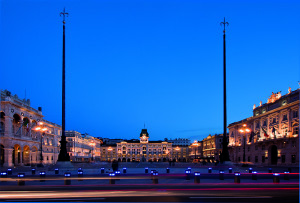 Coffee in Trieste is also linked to the literary culture of the city: you can find many old coffee houses, where once it would have been possible to meet writers and poets: James Joyce, Italo Svevo and Umberto Saba.
Also worth seeing are Piazza Unità, the largest square in Europe opening onto the sea, and the Molo Audace.
The religious diversity of the city takes concrete form in the buildings, so in addition to the Catholic churches (e.g. the Cathedral of San Giusto),there are old places of worship for the Greek and Serbian Orthodox, an important Synagogue, the Lutheran Church, and the Waldese who meet in the oldest church in the city, the Basilica of San Silvestro.
Coffee in Trieste is also linked to the literary culture of the city: you can find many old coffee houses, where once it would have been possible to meet writers and poets: James Joyce, Italo Svevo and Umberto Saba.
Also worth seeing are Piazza Unità, the largest square in Europe opening onto the sea, and the Molo Audace.
The religious diversity of the city takes concrete form in the buildings, so in addition to the Catholic churches (e.g. the Cathedral of San Giusto),there are old places of worship for the Greek and Serbian Orthodox, an important Synagogue, the Lutheran Church, and the Waldese who meet in the oldest church in the city, the Basilica of San Silvestro.
Gradisca d'Isonzo
Gradisca d'Isonzo is a small town near the city of Gorizia.
The first historical evidence of the existence of Gradisca dates from 1176 when the town is mentioned in an important document of the Council of Aquileia. The area was probably inhabited during the Roman and Longobard periods but in medieval times it was caught in the middle of clashes between the Counts of Gorizia and the Patriarchs of Aquileia. Only in 1420 was a lasting solution achieved, with the occupation of all of Friuli by the Republic of Venice.
To defend against the incursions of the Turks who were attacking the Republic of Venice on its eastern border, the Venetian Republic decided to build a defensive line along the Soca/Isonzo River. 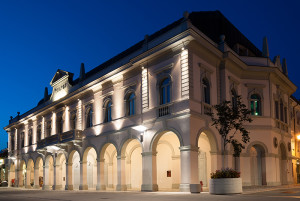 By 1500 this had become a fortress with a massive walls. Inside were both the military command and a civil community with Church and Governor’s house. In 1511 Gradisca was conquered by Austria.
Under Napoleon, whose overnight stay at the Palazzo de Fin-Patuna is memorialised, Gradisca was twice occupied by the French, albeit briefly, before returning in 1813 to the House of Hapsburg.
With the outbreak of the First World War, Gradisca found itself just behind the front line of the “Carso Isontino”, across the River Soca/Isonzo. In October 1917, during the retreat of Caporetto, the town was levelled by the retreating Italian army. Only a few houses in the old town and the Church of Our Lady of Sorrows survived. On January 6, 1921, the peace agreement, following the defeat of the Austro-Hungarian Empire, Gradisca was annexed to the Kingdom of Italy.
Again on Sept. 12, 1943 Gradisca was afflicted by a World War, being occupied by the German army. Many people from the area and from Gradisca itself joined the Resistance, while Allied bombs also fell of the town.
On April 29, 1945 Gradisca the German troops left and on May 5 an English officer moved into the town hall, becoming the first military governor of the area of Gradisca. Only later, in September 1947, was Gradisca returned to Italy. Since then the city has led a normal daily existence and is part of the Province of Gorizia.
By 1500 this had become a fortress with a massive walls. Inside were both the military command and a civil community with Church and Governor’s house. In 1511 Gradisca was conquered by Austria.
Under Napoleon, whose overnight stay at the Palazzo de Fin-Patuna is memorialised, Gradisca was twice occupied by the French, albeit briefly, before returning in 1813 to the House of Hapsburg.
With the outbreak of the First World War, Gradisca found itself just behind the front line of the “Carso Isontino”, across the River Soca/Isonzo. In October 1917, during the retreat of Caporetto, the town was levelled by the retreating Italian army. Only a few houses in the old town and the Church of Our Lady of Sorrows survived. On January 6, 1921, the peace agreement, following the defeat of the Austro-Hungarian Empire, Gradisca was annexed to the Kingdom of Italy.
Again on Sept. 12, 1943 Gradisca was afflicted by a World War, being occupied by the German army. Many people from the area and from Gradisca itself joined the Resistance, while Allied bombs also fell of the town.
On April 29, 1945 Gradisca the German troops left and on May 5 an English officer moved into the town hall, becoming the first military governor of the area of Gradisca. Only later, in September 1947, was Gradisca returned to Italy. Since then the city has led a normal daily existence and is part of the Province of Gorizia.
© Foto Castello di San Giusto: Milani
© Foto Cattedrale di San Giusto: Paolo Tosolini
© Foto Caffè San Marco Trieste: Kikki99 by Flickr
© Foto Teatro di Gradisca: Alberto Cabas Vidani

